If you’ve been bottle feeding your baby for a while, or you’ve just started and possibly want to bottle feed and breastfeed at the same time, you’ve probably come across the term “paced bottle feeding” or “pace feeding“. And now you might be wondering what it is, what its benefits are, and how it’s done.
My wife and I bottle fed our first daughter straight from birth, as my wife couldn’t breastfeed, and we soon realized how my daughter was struggling with the flow. Introducing pace feeding was a game changer and, as a result, we had a much happier baby!
In this article I will go through the pace feeding method: what it is, its benefits and how to do it right, with step-by-step instruction. If you are considering planning a pumping schedule, take a look at our general article as an introduction. In this article, I’ve also included extra tips I have learnt along the way!
Note: this article was written in collaboration with Sonita Patton, a Certified Lactation Consultant (IBCLC) and author of the blog Nurse Patton.
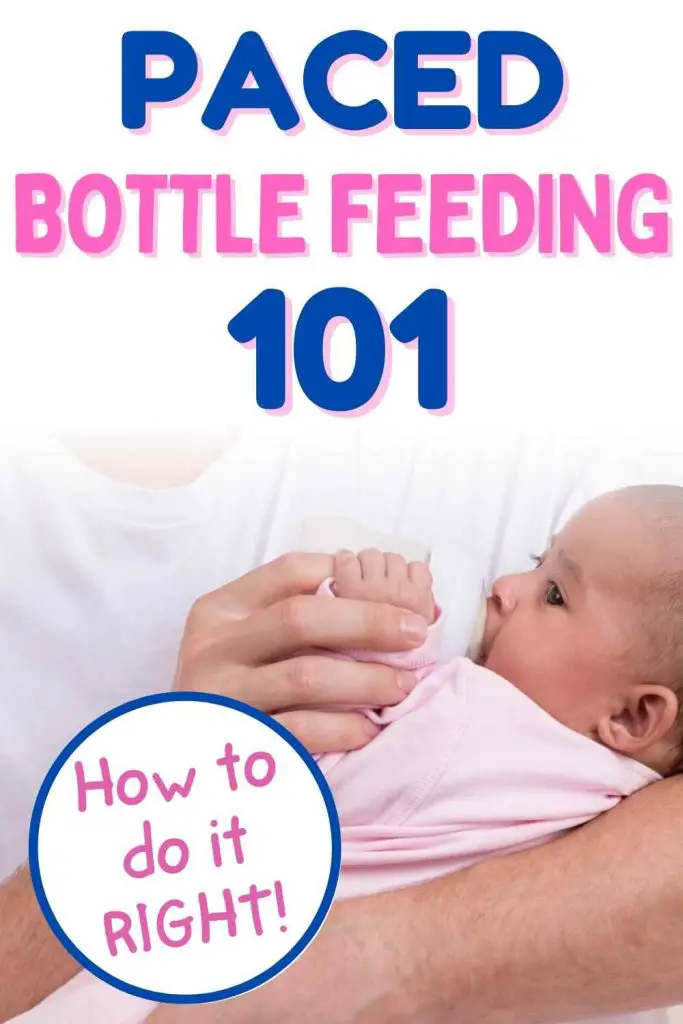
What is Paced Bottle Feeding?
The paced bottle feeding technique is a way of bottle feeding that mimics breastfeeding. It slows down the flow of milk from the bottle, allowing your baby to feed more slowly (“pacing” themselves) and take more breaks. This avoids feeding too fast or overfeeding, which usually results in discomfort for the baby, spitting up and fussiness. Or it can even result in your baby suddenly refusing the bottle.
While it is a recommended technique for babies that both bottle feed and breastfeed, it also has many benefits for babies that are bottle feeding exclusively.
Related:
– Sudden Drop in Milk Supply: Signs, Causes and What to do to increase it again
– 25 Formula Feeding Tips to Make Bottle Feeding a Breeze
– Baby Suddenly Refusing Bottle (Why & 19 Things to Try!)
How to Pace Feed with the Bottle
Here’s a pace bottle feeding video that shows very well how to pace feed a baby with a bottle.
And here are step-by-step instructions for the paced feeding method:
- Hold baby on your lap in a almost completely upright position, supporting the head and neck. You don’t have to hold your baby at a 90-degree angle. However, keep them upright just enough so that the milk doesn’t pour into their mouth.
- Tickle your baby’s lip so they open their mouth wide.
- Insert the nipple into baby’s mouth. Baby will “latch” to the bottle just like they would do with the breast nipple.
- Hold the bottle horizontal. This also helps with the milk flow, preventing the milk from pouring down into your baby’s mouth.
- Let your baby begin sucking on the nipple without milk, then tip the bottle just enough for the milk to reach the holes in the nipples. This mimics the let-down in breastfeeding and can help if you are worried about your baby preferring the bottle over breast.
- Let your baby suck for about 3-5 continuous swallows (20-30 seconds).
- Tip the bottle down, giving your baby a little break. If the baby takes a break on their own, before you tip the bottle down, that’s great: let them do that! This also mimics breastfeeding, during which babies often pause.
- When baby begins to suck again, tip the bottle up to allow the milk to flow into the nipple again.
- Change sides halfway through feeding. This helps baby avoid a side preference, which can help particularly if you are breastfeeding and bottle feeding at the same time. It also allows for new views and eye contact, which is great for your baby’s development.
- Continue until your baby shows signs of being full, such as stop sucking, start refusing the nipple, start falling asleep or have open and relaxed hands. Do not force feed the last few drops of milk just because you want them to finish the bottle! 🙂
Pace feeding should take as long as a breastfeeding. Instead of chugging down the bottle in 5 minutes, the baby should be taking 15 minutes or so to eat. Follow the baby’s cues and when she seems full, stop.
Sonita Patton (IBCLC)
Pace Feeding vs Traditional Bottle Feeding

Bottle feeding traditionally involves the baby lying down on the parent’s lap, and the parent holding the bottle almost vertical over the baby’s mouth. With this feeding method, the milk pours out into baby’s mouth and they will usually start gulping to keep up with the flow.
Pace feeding, on the other hand, sees the baby being more upright and the bottle being horizontal. This allows baby to be more in control of the flow and the speed at which they want to drink. Milk is not forced into their mouth, so they can eat at their own pace.
When to Feed your Baby
If you are wondering when or how often you should be feeding your baby, the best thing is to look out for their hunger cues! While a feeding and sleeping schedule, or the instructions on the formula tin, can be very useful (particularly if you are a first time mom and figuring it all out), following your baby’s cues is the best thing you can do.
Early Hunger cues in newborns are:
- Fists moving to the mouth
- Head turning to look for the breast
- Becoming more alert and active
- Sucking on hands or lip smacking
- Opening and closing mouth
Later cues are fussing and crying, but you really want to avoid getting to that stage. If you are just starting to breast or bottle feed and are struggling to recognize the signs, don’t worry: you’ll learn as you go 🙂
The Benefits of Paced Bottle Feeding
Whether you are bottle feeding in between breastfeeding, or bottle feeding exclusively, paced bottle feeding has may benefits for your baby.
I recommend paced feedings to all mommies who are going to be using a bottle. Whether the bottle will only be used occasionally, or if the bottle is used exclusively, there are still many benefits to paced feedings. Even babies who are exclusively formula fed benefit from paced feedings.
Sonita Patton (IBCLC)
Here’s a list of all of the benefits.
1) Baby Feeding the Right Amount
By controlling the flow of milk, baby gets a chance to take charge of how much milk they are drinking, instead of being “forced” to have the whole bottle. This allows the baby to learn how to self-regulate and feed the right amount, just like they would do if breastfeeding.
Also, when gulping down too much formula at once, they are more likely to bring that up when being burped or after a feed. And will feel hungry again sooner than with pace feeding.
I remember we used to struggle with my daughter at the beginning when feeding her with the bottle the traditional way. She used to bring up so much of her feed during the burps and feed so often! It felt like she was always showing signs of hunger 🙂
If you are worried about your baby feeding too much and gaining too much weight, check out these simple ways to weigh your baby at home to keep track of their growth.
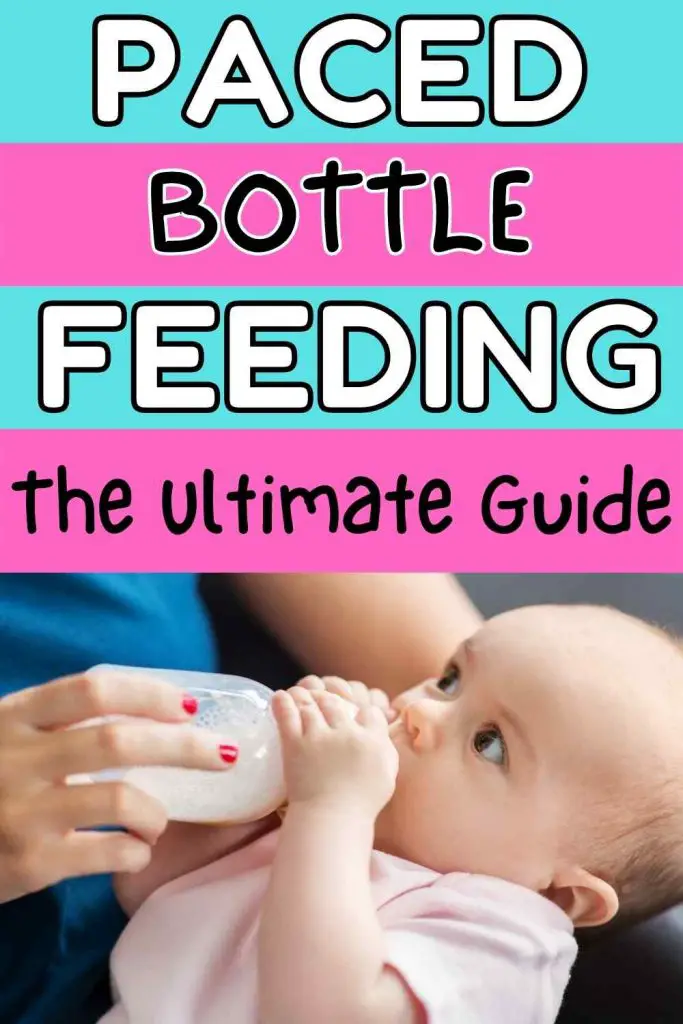
2) Less Stressful and Messy
Again, when the milk is “forced” down baby’s throat with the traditional way of bottle feeding, the baby keeps having to gulp to avoid chocking. This can be quite stressful for your baby, who will struggle to find the time to take a breath in between sucking! They might even start refusing the bottle.
By slowing the flow down and taking those breaks, you will allow your baby to drink at their own pace.
It will also be less messy, trust me! We had to put two bibs around my daughter’s neck to try and soak in all the formula that used to flow down her cheeks. The flow was so fast for her that she couldn’t keep up, and used to spit most of it out.
3) Stronger Bond Between Parents and Baby
Paced Bottle Feeding has also been found to help strengthen the bond between parents and baby by helping parents tune into their babies’ cues.
4) Less Risk of Colic
Gulping to keep up with the flow of milk with the traditional method of bottle feeding also has the disadvantage that the baby ingests too much air. This is more likely to cause gas which, together with overfeeding, can cause discomfort and be associated with colic symptoms.
I would definitely try paced bottle feeding before going through all the other tips on how to soothe a crying baby, particularly if it looks like your baby is in discomfort!
5) Ability to Self Regulate
Some studies suggest that breastfeeding reduces the risk of childhood obesity and, according to this research, this is due to the child’t ability to better self-regulate compared to bottle fed babies.
Breastfed babies and babies that are bottle fed with the pace feeding technique, can better understand when they are full. Therefore, the chances that they are going to overeat and be overweight are lower.
On the other hand, for babies that are bottle fed the traditional way it’s harder to self-regulate: they feed so fast that the body doesn’t have enough time to send signal to the brain to tell it that it’s full.
6) Less Ear Infections
Contrary to Pace Feeding, Formula Bottle Feeding in a lying flat position is associated with an increased frequency of ear infections. This happens because, by lying down, formula can get into the Eustachian tubes and middle ear and cause an infection.
This doesn’t really apply to bottle feeding with breastmilk, as breastmilk inhibits the formation of bacteria, contrary to formula that encourages it!
7) Less Tooth Decay
Paced Bottle Feeding can also decrease the likelihood of your child developing tooth decay. This is because, by sitting your baby upright and allowing them to control the flow, formula doesn’t pool in their mouth. It goes straight down their throat and gets swallowed.
If you are breastfeeding with your baby in a flat position, this doesn’t really happen though. With breastfeeding, the baby is always actively sucking (no matter the position they are in), otherwise the milk doesn’t come out! This means breastmilk gets swallowed straight away and doesn’t get a change to stay in the mouth.
8) Less Discomfort if Congested
Because baby is going to be fed in a vertical position, it’s also going to be much easier for them to feed when congested and struggling to breathe.
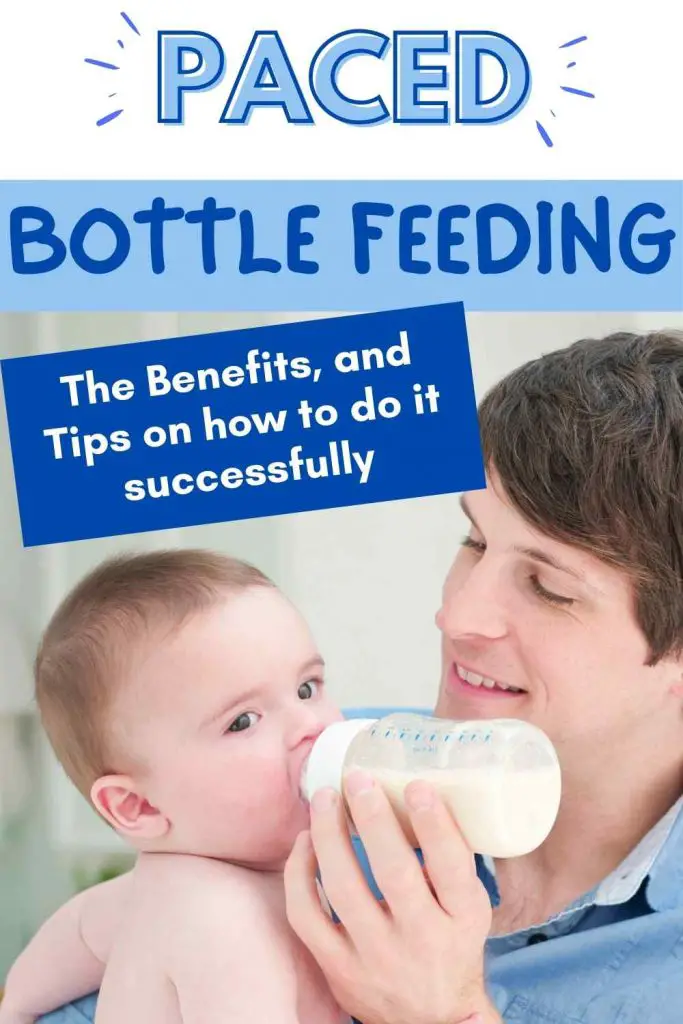
Benefits for Breastfeeding Moms
The benefits listed below are specific to breastfeeding moms who alternate formula feeding to breastfeeding.
If you need help with breastfeeding, also check out these Online Breastfeeding Courses, including some FREE courses.
1) No Side Preference
With Paced Bottle Feeding, switching baby from one side to the other in between feeding helps baby avoid a side preference. This is beneficial and reassuring for a breastfeeding mom.
It also allows for new views and eye contact, which is great for your baby’s development.
2) No “Nipple Preference”
There’s no such thing as “nipple preference”, more like “flow preference”. In fact, once the baby starts getting used to the fast flow of the bottle, then they might get used to it and prefer the bottle over breast.
Paced bottle feeding helps avoid that.
3) Less Pumping
Another disadvantage of bottle feeding the traditional way compared to paced bottle feeding is that, because your baby is most likely being over-fed, you will need to keep pumping more milk than what’s actually necessary!
This can make you think you have a low milk supply when, in reality, it’s your baby that’s over feeding.
Related: Sudden Drop in Milk Supply: Signs, Causes and What to do to increase it again
4) Better Breastfeeding Relationship
Overall, pace feeding supports the breastfeeding relationship by allowing your baby to feed equally from either the bottle or the breasts, and the mom producing the right amount of milk when pumping.
This usually leads to being able to breastfeed successfully for a longer duration.
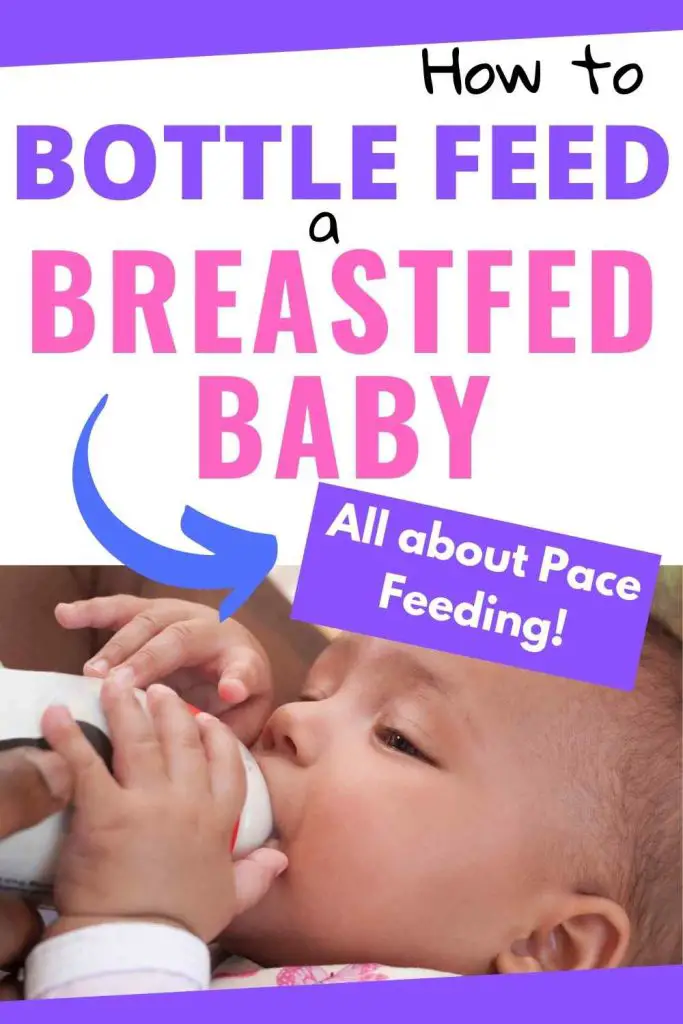
When there’s no need to Pace Feed
If you have a natural fast flow of breastmilk, and your baby is happy and used to feeding from both breasts in a short amount of time (5-10 minutes, instead of 10-20 minutes), then you probably don’t need to worry too much about Paced Bottle Feeding.
You baby is already used to a fast flow, so will probably adapt very well to either the traditional way of bottle feeding or the pace feeding approach.
Tips for Successful Pace Feeding
Here’s some tips on how to be successful at paced bottle feeding 🙂
1) Be Patient
It can be a bit frustrating to have to pause throughout the feed to allow your baby to breathe, particularly if you are in a rush or you are used to the traditional way of bottle feeding and to being done in 5 minutes! I know, I have been there!
But remember to be patient, what you are doing for your baby is the right thing and the benefits will pay off, promise!
2) Choose the Right “Nipple Flow”
The nipples of the bottles come in different “flows” or “flow rates”: the larger the holes and the more in number, the faster the milk or formula will come out of the bottle.
This can also affect pace feeding: even though the bottle is horizontal and you are not forcing milk into your baby’s mouth, if the nipple allows too much milk to come out, your baby may still struggle with the flow, particularly when young. Once they are a bit older, they can move up to a faster flow without a problem.
My wife and I were honestly so clueless about this when we bought the first bottles! We just started feeding our daughter with whatever nipple we got with the bottle, until we realized that, even with pace feeding, she was drinking way too fast and spitting milk everywhere. Once we changed to a lower flow rate, she was able to feed much better!
Related: 25 Formula Feeding Tips to Make Bottle Feeding a Breeze
3) Burp Often
Burping often should be done whether you are bottle feeding or breastfeeding. Remember that it’s normal for your baby to swallow air while sucking, and burping often allows them to release that gas before it becomes uncomfortable.
And while you might think that pace feeding lets your child inhale more air during the pauses (when they are sucking, but no milk or formula is coming our of the bottle), the reality is they inhale way more air by gulping when bottle feeding the traditional way!
I remember I used to spend quite a lot of time with my daughters burping them throughout the feeds. Sometimes it can take a while for the burp to come up, but don’t get impatient and skip the burp, you will regret doing that!
And the older they get, the easier it is for them to burp: now that my daughter is 1 year old I don’t even burp her anymore, she does it herself at the end of the feed.
4) Give Your Baby Time to Adjust
Whether you have just switched from exclusively breastfeeding to pace feeding, or from traditional bottle feeding to paced bottle feeding, be aware that it may take some time for your baby to adjust to this new way of feeding. It can also be quite normal for a 2-3 month old baby who’s being both breastfed and bottle fed, to suddenly refuse the bottle.
They might get a bit frustrated, and they might need to get used to the new bottle or flow. Remember that it is all normal and your baby just needs some time to adjust.
Again, be patient and you’ll see that both you and your baby will get there in no time!
Best Bottles for Pace Feeding
The one million dollar question! Which ones are the best bottles for paced bottle feeding, particularly when bottle feeding and breastfeeding at the same time?
I think the best answer is: whatever bottle or nipple your baby likes!
Some people say a narrower nipple, like the one from Dr. Brown’s Bottles or ThinkBaby, is best for babies because they allow for a deeper latch like when breastfeeding.
Other people prefer a wider nipple that better resembles the shape of the breast, such as the one from Tommee Tippee or Philip Avents bottles.
I personally don’t think that the shape of the bottle nipple matters that much. If you think about the breast nipple, it changes in shape when baby is breastfeeding, and that change in shape can’t really be replicated by the bottle. So, it’s about what baby prefers. Some people have to try quite a few different bottles before they find one that their baby likes!
We personally used the Philip Avents Bottles with our first daughter, and she never had a problem with them 🙂
What I think is more important than the nipple shape, is paying attention to the nipple flow rate, like I mentioned above. Sonita (IBCLC) recommends a slow flow nipple as well. Start with a slow flow rate, and then increase it only if and when your baby is ready.
How about you? Are you a mom that tried paced bottle feeding and found it useful too? Did you come across other benefits or tips for pace feeding? If so, please let me know in the comments below! I’d love to know about your experience 🙂
FAQs
How long should Paced Bottle Feeding take?
Paced Bottle Feeding should take 10-20 minutes, the same amount of time as breastfeeding. If it takes less time, around 5-10 minutes, it means that your baby is feeding too fast and you need to adjust the position of the baby and/or bottle.
Does Paced Bottle Feeding cause gas?
No it doesn’t! This is a big myth of paced bottle feeding, because people are worried that when the baby is sucking without any milk going through, then they are just inhaling lots of air.
While this is true, and you need to burp your baby frequently, it is also true that bottle feeding the traditional way, with the baby constantly gulping, lets your baby inhale way more air and is more likely to cause gas.
Can I breastfeed and bottle feed at the same time?
Of course you can! There are so many women out there that breastfeed and bottle feed at the same time. Paced Bottle Feeding is just a way of bottle feeding that really helps with a better breastfeeding relationship, as it mimics the way baby feeds from the breasts.
Paced Bottle Feeding: Final Thoughts
Paced Bottle Feeding has many advantages for babies that are being fed with a bottle, whether exclusively or intermittently. So, if you are struggling with feeding your formula fed or breastfed baby with a bottle, it’s definitely something you should give a try!
If you are also alternating formula feeding to breastfeeding, it can make your breastfeeding journey a much more pleasant one. If you can do it right, you are guaranteed to have a much happier and healthier baby!
Fore more information and tips on feeding baby, whether you are breastfeeding or formula feeding, also check out these related posts:
- 30 Formula & Bottle Feeding Tips (to Make it Easier!)
- Sudden Drop in Milk Supply (Signs, Causes & How to Fix it!)
- How to Stop Breastfeeding a 1 Year Old at Night
- 20+ Best Online Breastfeeding Courses of 2021 (FREE Classes too!)
- 14 Drinks that Increase Milk Supply
- Baby Suddenly Refusing Bottle (Why & 19 Things to Try!)
- 5 Best Tips on How to keep Baby Bottle Warm at Night
- How to Store Formula Milk for Night Feeds (6 Solutions to Fit your Needs!)
- 8 Tips for Flying and Traveling with Breast Milk and a Breast Pump
Are you a mom who’s experiencing issues bottle feeding your baby and have some more questions about paced bottle feeding? Or are you a mom who’s used the pace feeding technique with their baby in the past and you have more tips to share? Then please let me know in the comments below – I would love to hear from you!
Did you find it useful? Pin It!
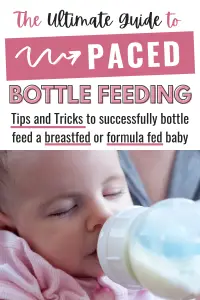


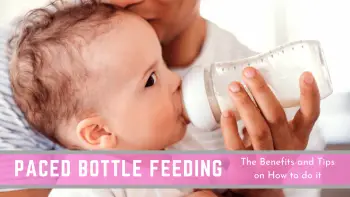
Really insightful and great to see that you thought of everything whether you breastfeed or not. Thanks for sharing!
This is definitely so informative especially that I feed my niece with bottled milk. I find the early hunger cues of newborn insightful. Also, with the benefits! Hope more moms get to see this! Thank you.